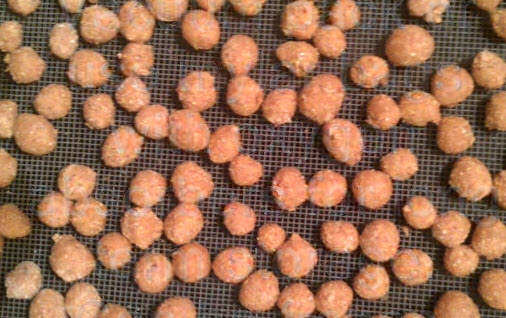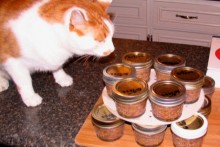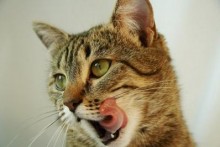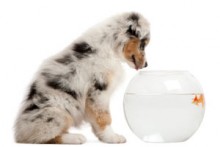DIY Cat Kibble
Make dry food for your cat! Combine the dry ingredients in a bowl. Place the meat in a bowl or blender and mince it well. Add the oils and clam juice to the meat and mix well. Combine the wet and dry mixtures. Sprinkle whole wheat flour onto a flat surface and knead the dough on the floured area. Roll a small piece of dough into a rope, cut the rope into small pieces and set the kibble pieces on a baking sheet. Bake the kibble, shaking the trays frequently to rotate the kibble.
Ingredients: whole wheat flour, wheat germ, soy flour, corm meal, nonfat dry milk, vegetable oil, cod liver oil, clam juice, and your choice of a meat, such as mackerel, sardines or chicken, as well as wheat germ oil
Update: Although this recipe calls for 5 tbsp vegetable oil, our research has shown that it should use 3 tbsp vegetable oil and 2 tbsp wheat germ oil instead in order to provide the necessary level of vitamin E for your cat.






And where is the taurine coming from? Cats without taurine die. Period. Cooking destroys taurine. Please, please, PLEASE do not do this recipe as is. Add supplements to keep your cat healthy.
Dawn,
You bring up a very important point, so let’s calculate the amount of taurine in this recipe. According to Dr. Pitcairn’s Complete Guide to Natural Health for Dogs and Cats, the most amount of taurine lost to heat is 80%. Dr. Pitcairn’s book also states that cats need a minimum of 25 mg taurine per day.
According to the University of California School of Veterinary Medicine, mackerel has 2070 mg of taurine per kg. There are 35 ounces in a kilogram and this recipe calls for 15 oz of mackerel. That means there is a starting amount of 887 mg taurine. If the maximum amount (80%) is lost to heat, that would leave 177.4 mg taurine in the final product. However, this recipe makes 4 pounds. If a cat received 3/4 of a cup of food per day, and we assume that 1 pound equals 2 cups of the food, then there is 44.3 mg taurine per pound, which equals 22 mg per cup, which would equal 16.6 mg taurine per 3/4 cup serving. If a cat needs a minimum of 25 mg taurine per day, then you are correct that the mackerel alone does not provide the amount necessary.
However, this recipe also uses clam juice. I was not able to find an exact level of taurine in clam juice, so I’ll use the closest calculation I could find, which is for boiled, whole clams, which contain about 446 mg taurine per kg. If 2 cups of clam juice are used, that is about 16 ounces. There are 35 ounces in a kilogram, so that means that there is 203 mg taurine at the start. If 80% is lost to heat, that leaves 40.6 mg taurine left in the food. Divided by 4 pounds, that’s 10 mg taurine per pound, which equals 5 mg per cup, so a 3/4 cup serving would contain 3.75 mg taurine from the clam juice approximately. Added to the 16.6 mg from the mackerel, that’s 20.35 mg taurine in the food. Again, still not enough to equal the 25 mg needed.
So, if the maximum amount of taurine is lost to heat, then you are correct; this recipe does not provide enough. However, this recipe is cooked using a dehydrator, which has a very low cooking temperature (usually only about 150 degrees Fahrenheit). Due to that, it is likely that much less than the maximum amount of taurine is lost to heat than it would be if the kibble was baked (which would be at least 2-3x higher of a temperature).
If we re-do the math with only a 50% taurine loss, then the mackerel alone would provide 41.5 mg taurine per 3/4 cup serving. That is well over the minimum amount of taurine needed.
Ultimately, the only way to know for sure would be to test the final product to find out. There are laboratories that can be found online that could test the kibble to find out. If you don’t want to test it and still want to be safe though, you can provide your cat with a serving of clam juice to drink each day in addition to this food. Since cats often don’t hydrate themselves very well, it is usually recommended that cats receive wet food instead of dry food, so adding clam juice to their diet would help with that aspect as well.
If you are still concerned about the taurine, a taurine supplement can be added to the recipe to ensure that your cat receives enough of the nutrient. However, it is important to note that not all vitamins are safe to add to your cat’s food. The ASPCA says that “due to the practice of over supplementation, hypervitaminosis—poisoning due to excess vitamins—is more common these days than hypovitaminosis, or vitamin deficiency! Excess vitamin A may result in bone and joint pain, brittle bones and dry skin. Excess vitamin D may result in very dense bones, soft tissue calcification and joint calcification.”
In thinking about that, the cod liver oil should be considered. Cod liver oil is high in vitamin A and this recipe uses 1 tbsp cod liver oil. If there is 5000 IU vitamin A in one teaspoon (according to the The Weston A. Price Foundation), that means that one tablespoon contains 15000 IU. Divided by 4 pounds, that is 3750 IU per pound. According to Dr. Foster and Smith, cat food should contain a minimum of 2272 per pound of food, so this serving does meet the minimum requirement. It is also way below the maximum safe amount, so that’s ideal.
To be safe, let’s also calculate the amount of vitamin E. The Dr. Foster and Smith website says that there should be a minimum of 14 IU per lb of cat food. According to the USDA, there is 38.1 mg vitamin E per cup of canola oil. That means that there is 2.38 mg per tablespoon. This recipe uses 5 tablespoons, so that is 11.9 mg total. Divided by 4 pounds, that is 2.97 mg vitamin E per pound. According to Riverside, 1 IU of vitamin E is equal to 1 milligram. Therefore, based on the canola oil alone, this recipe does not provide enough vitamin E. Wheat germ has 18.07 mg per cup, and this recipe uses 1 cup of wheat germ, so that adds in an additional 4.5 mg per pound, which equals 7.48 mg vitamin E per pound from both the vegetable oil and the wheat germ. That is still only half of the minimum amount recommended. Mackerel has 1.29 mg per 3 ounces, there are 15 ounces used for this recipe, so that is 6.45 mg vitamin E total, which equals an extra 1.61 mg per pound of food, bringing the total up to 9.09 mg per pound. Wheat flour has .85 mg per cup, this recipe uses 3 cups, so that is only an extra .63 mg per pound, making the total 9.72 mg vitamin E per pound. Soy flour contains 1.64 mg vitamin E per cup, this recipe uses 2 cups, so that is an extra .82 mg per pound, bringing the total to 10.54 mg vitamin E per pound. Clam juice contains .74 mg per cup, which brings the total up to 10.91. Therefore, this recipe is just over 3 mg short of the minimum vitamin E requirement. To remedy that, one or two of the vegetable oil tablespoons could be swapped for wheat germ oil since wheat germ oil contains a whopping 325.69 mg. vitamin E per cup (20 mg per tablespoon, divided by 4 pounds, would be an extra 5 mg vitamin E per pound).
It should also be noted that the mackerel provides more than the minimum vitamin D needed, but well below the maximum safe amount.
So as it turns out, taurine isn’t the issue with this recipe, it’s the vitamin E! Thanks so much for commenting Dawn and inspiring this investigation! You are right that it is very important these things be considered when making food for pets.
Source: Dr. Pitcairn’s Complete Guide to Natural Health for Dogs and Cats
Source: Department of Molecular Biosciences, School of Veterinary Medicine, University of California – Taurine concentrations in animal feed ingredients; cooking influences taurine content
Source: Angelfire – Food Conversions from POUNDS to CUPS
Source: ASPCA – Nutrients Your Cat Needs
Source: Cat-World – Vitamin A Toxicosis in Cats
Source: The Weston A. Price Foundation – Cod Liver Oil Basics and Recommendations
Source: Dr. Foster and Smith – Fat Soluble Vitamins: A, D, E & K in Cats
Source: United States Department of Agriculture – Basic Report: 04582, Oil, canola
Source: United States Department of Agriculture – Basic Report: 08084, Cereals ready-to-eat, wheat germ, toasted, plain
Source: United States Department of Agriculture – Basic Report: 15046, Fish, mackerel, Atlantic, raw
Source: United States Department of Agriculture – Wheat flour, whole-grain
Source: United States Department of Agriculture – Basic Report: 04038, Oil, wheat germ
Source: United States Department of Agriculture – Basic Report: 16115, Soy flour, full-fat, raw